Potatoes are easy, cool-season vegetables to grow and can prosper when given ample irrigation, proper fertilization, and overall care. They can be a good investment and a fun gardening venture to explore.
To plant potatoes, choose your preferred potato variety and purchase disease-free seed tubers from a reputable distributor or grower. Using a sharp knife, cut tubers into 1.25-inch chunks with at least one eye each. Plant the pieces 3 to 5 inches deep into the soil, 10 to 12 inches apart, in rows 30 to 36 inches apart.
This guide will provide you with everything you need to know about planting potatoes, when and where to grow them, how to harvest, potato pests and diseases, and other interesting information. Read further for more!
About Potatoes
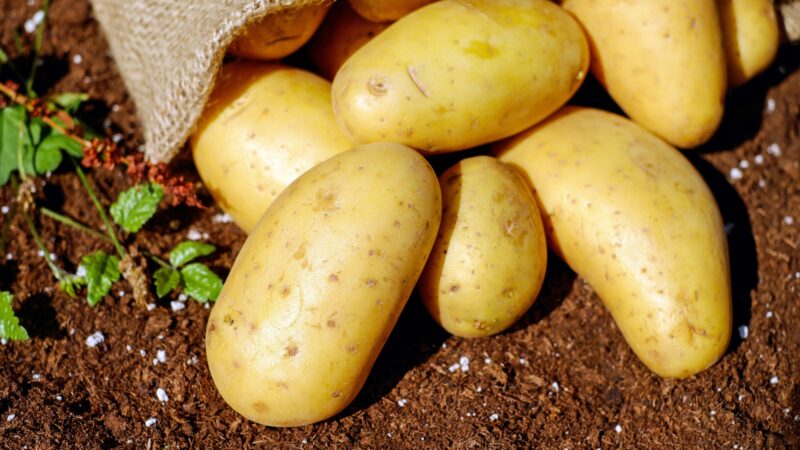
Potatoes (Solanum tuberosum) are a plant that belongs to the nightshade family (Solanaceae). It is characterized by having tubers or enlarged stems or roots where shoots emerge and plants get nutrients.
Additionally, they are native to South America and have been cultivated since as early as 400 BCE. They have become one of the most widely consumed non-grain food crops worldwide.
Is a Potato a Vegetable?
Potatoes are considered starchy, tuberous-rooted vegetables. As its description suggests, potatoes contain more starch than other vegetables, providing more calories and less fiber.
What Is the Best Month to Plant Potatoes?
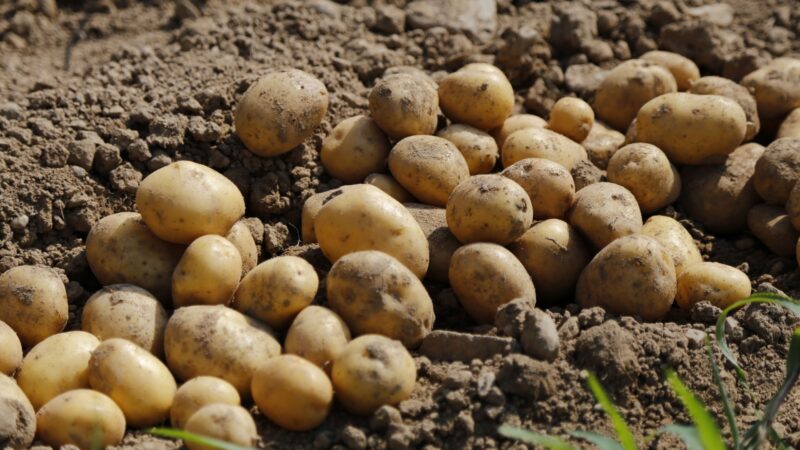
Ideally 2 to 4 weeks before the last expected spring frost, sometime in March or early April. However, there are midseason (Red Pontiac, Viking) and late potato varieties (Katahdin, Kennebec) that may be planted in the first week of July.
Can You Plant Potatoes in the Fall for Next Year?
You can plant potatoes in the fall for next year, but it depends on your geographic location. As long as day temperatures are warm enough while night temperatures are cool enough, you can expect successful planting with potatoes.
Can Potatoes Grow in Winter?
Potatoes can grow in winter. Potatoes that are planted in late winter or grow in the winter season can resist light frost.
However, hard frosts may regress growth. This is why you must protect your plants from harsh winter conditions by storing them in cardboard boxes, bushel baskets, or ventilated bins.
When Is It Too Late to Plant Potatoes?
Generally, winter plantings are not recommended since most potatoes are not hardy to frost. However, as long as the plants are sufficiently protected and well taken care of, there is no considered “too late” planting time.
What Happens if You Plant Potatoes Too Late?
If you plant them at a later time, there will be less time for them to grow. The winter frost or summer heat will slow or completely stop the formation of tubers.
How Long Does It Take to Grow Potatoes?
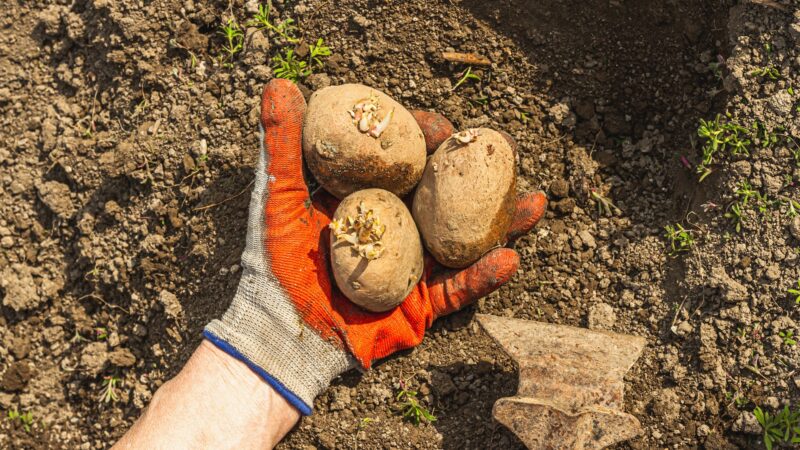
It depends on the variety. Generally, it may take any time between 12 to 20 weeks after planting.
Where to Plant Potatoes?
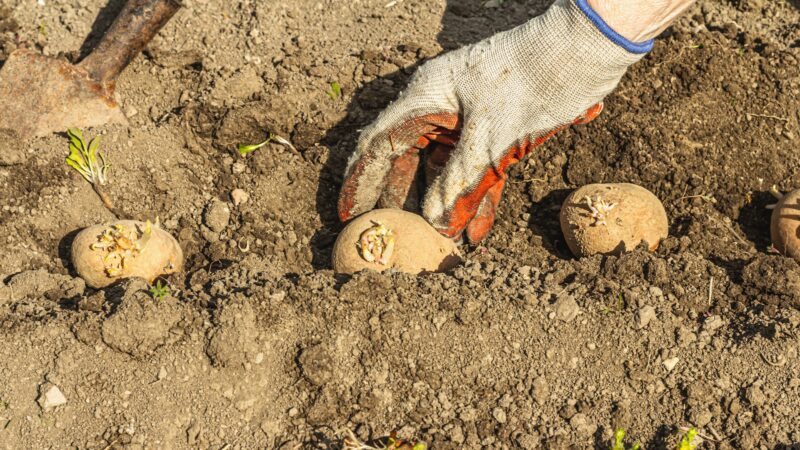
Potatoes can grow in many types of soil, but they grow best in loose, fertile, well-draining, slightly acidic soils.
Poorly drained soils can produce badly-shaped potatoes, decreased yields, and tuber rot, while soil with higher pH levels will increase the risk of potato diseases such as scabs. Potatoes should receive full sun where they are planted.
How to Plant Potatoes?
Step 1: Choose your potato variety based on what you’re growing potatoes for. Most varieties fall between the following categories:
- Mealy or dry-fleshed potatoes. Characterized by having high starch content. Also, it is used for baking and processing (chips and frozen french fries) since they tend to become brittle enough but can slough when boiled. Examples are Russets and Idahos.
- Waxy or moist-fleshed potatoes. Have low starch content and are used for mashing, boiling, chip processing, and canning, as they hold together nicely when cooked. Examples are Red Bliss and Russian Banana.
- All-purpose potatoes. Have a starch content that falls between mealy and waxy potatoes and can be used for a variety of purposes. Examples are Yukon Gold and Purple Majesty.
Step 2: Purchase healthy seed tubers of the potato variety of your choice from a certified seed distributor or potato grower. Avoid purchasing from grocery stores as the potatoes may be treated with chemicals to keep their tubers dormant, causing slower growth.
Step 3: Prepare your soil by conducting a soil test. Potatoes prefer slightly acidic soils with compost or manure incorporated into it.
Step 4: Using a sharp, sterilized cutting tool, cut the tubers into 1.25-inch chunks, with each piece having at least one “eye” or small sprouts or notches where shoots will emerge.
Step 5: Place the potato chunks on a tray at room temperature for a few days or until the surface where you cut them has dried out and formed an outer protective layer. If sprouts already started forming, be extra careful not to rub them off when planting.
Step 6: Plant the seed pieces 3 to 5 inches deep into the soil when their temperature reaches between 60°F to 70°F. The cut side should be facing down and covered with 4 inches of compost or soil. Pieces should be placed 10 to 12 inches apart in rows of 30 to 36 inches apart.
Step 7: Once shoots emerge, hill the soil up as the plants grow. Do so by pulling soil between the rows using a hoe and then mulching over the potatoes. At the end of the growing season, you should have hilled a total of 6 to 8 inches of soil.
Step 8: Maintain potatoes using the following care guide:
- Watering. Water thoroughly once or twice a week, do so more often if your soil is sandy. You don’t have to wait for the soil to dry out between waterings.
- Fertilization. Apply 1.5 pounds of 10-10-10 fertilizer when the vines have reached a spread of 2 feet in diameter. You can also apply fertilizer 3 weeks before harvest.
- Weed Control. Perform regular, shallow cultivation using a hoe or any other suitable gardening tools.
- Insects. Regularly check your plants, especially the undersides of their leaves and stems if there are pests.
- Diseases. Prevent diseases by practicing crop rotation—plant potatoes in locations where other plants in the same family have also grown recently.
How to Harvest Potatoes?
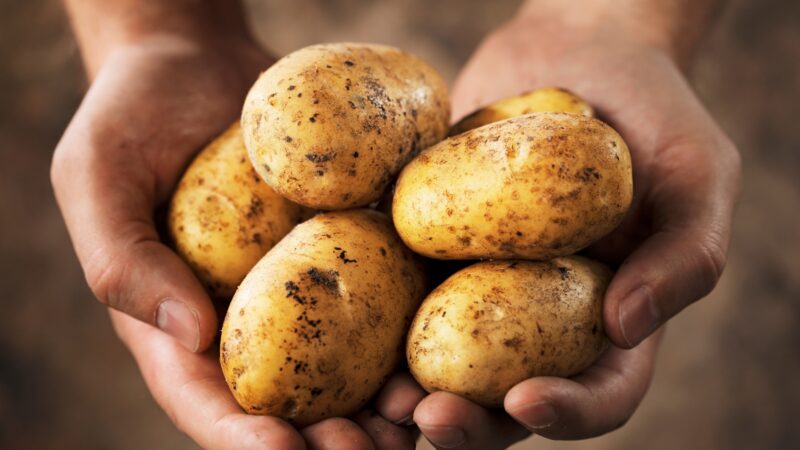
Before harvest, it may be necessary to remove and discard potato vines by using rotary choppers, flail beaters, or chemical vine killers containing diquat, carfentrazone, or glufosinate-ammonium if the top growth has become excessive.
Harvest when temperatures are between 60°F to 70°F. Begin harvest when flowers begin emerging on the plant. Remove the young “new potatoes” near the surface of the soil and leave the rest of the crop to mature and harvest at a later time.
Afterward, spread the potatoes on dry ground and allow them to dry off for several hours. Store in a cool, dark place.
Potato Pests and Diseases
Pests
1. Colorado Potato Beetle
- Symptoms: Presence of larvae, bright orange egg masses, or adult beetles on the underside of the plant’s leaves. Leaves and petioles may appear defoliated.
- Solution: Manual control (hand collecting)
2. Potato Leafhopper or Cabbage Looper
- Symptoms: Leaf damage which includes inward leaf rolling, dry brown margins, and irregular holes
- Solution: Manual control (hand collecting)
Diseases
1. Blight
- Symptoms: Older leaves will have small, dark lesions with rings or dark, water-soaked areas on the stems and leaves.
- Solution: Remove and discard infected foliage then water at the base of the plant, keeping the foliage dry.
2. Leaf-roll Virus
- Symptoms: Plant growth has been stunted or reduced and produces pale green or yellowish leaves.
- Solution: Control aphid populations to prevent the spread to other plants
3. Scab
- Symptoms: The plant will have raised and/or pitted corky areas
- Solution: Avoid using manure or lime in the first year the potatoes are grown.
4. Rhizoctonia
- Symptoms: Sprouts have reddish brown lesions or brown decay. Stems and stolons grow below ground.
- Solution: Plant potatoes at the right temperature, making sure that they are 3 to 5 inches deep into the soil.
List of Sources
Potatoes – https://fsi.colostate.edu/potatoes/
Home Garden Potatoes – https://extension.uga.edu/publications/detail.html?number=C1011